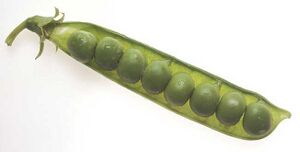Peas


In early times peas were grown mostly for their dry seeds. In modern times however peas are usually boiled or steamed which breaks down the cell walls and makes the taste sweeter and the nutrients more bio-available. Along with broad beans and lentils, these formed an important part of the diet of most people in Europe during the Middle Ages. By the 1600s and 1700s it had became popular to eat peas "green", that is, while they are immature and right after they are picked. This was especially true in France and England, where the eating of green peas was said to be "both a fashion and a madness". New cultivars of peas were developed by the English during this time which became known as garden peas and English peas. The popularity of green peas spread to North America. Thomas Jefferson grew more than 30 cultivars of peas on his estate. With the invention of canning and freezing of foods, green peas became available year round, and not just in the spring as before.
Fresh peas are often eaten boiled and flavoured with butter and/or mint as a side dish vegetable. Salt and pepper are also commonly added to peas when served. Fresh peas are also used in pot pies, salads and casseroles. Pod peas (particularly sweet cultivars called mange tout and sugar peas, or the flatter "snow peas," are used in stir fries, particularly those in American Chinese cuisine. Pea pods do not keep well once picked, and if not used quickly are best preserved by drying, canning or freezing within a few hours of harvest.
In India, fresh peas are used in various dishes such as aloo matar (curried potatoes with peas) or matar paneer (paneer cheese with peas - or the better known, cheesy peas), though they can be substituted with frozen peas as well. Peas are also eaten raw as they are sweet when fresh off the bush.
Dried peas are often made into a soup or simply eaten on their own. In Japan, China, Taiwan and some South-east Asian countries, including Thailand and Malaysia, the peas are roasted and salted, and eaten as snacks. In the UK, dried yellow split peas are used to make pease pudding (or "pease porridge"), a traditional dish. In North America a similarly traditional dish is split pea soup. Dried peas can be used for blind baking.
The best ways to cook peas
- Sauté in butter or olive oil for 2 or 3 minutes, or slightly longer so the skins crisp-up
- Boil for 2 to 3 minutes
- Add to (boiled) rice dishes a few minutes before the rice is cooked
- Steam for a few minutes
- Microwave for a few minutes
- Sprinkle un-cooked into a salad
- Cook them by boiling or steaming, mash them add butter and a pinch of sugar and make pea puree
Minty peas is a simple way to cook garden peas.
How much does one cup of peas/green weigh?
Estimated US cup to weight equivalents:
| Ingredient | US Cups | Grams | Ounces |
|---|---|---|---|
| Frozen Peas | 1 Cup | 150 g | > 5 oz |
| Fresh Peas (shelled) | 1 Cup | 150 g | > 5 oz |
| Dried Peas | 1 Cup | 200 g | 7 oz |
Conversion notes:
Every ingredient has a cups to ounces or grams conversion table. Search for the ingredient, cup to weight conversions are at the end of each ingredient page.
We also have a generic conversion table and a portions per person lookup.
Seasonal Information: Peas
This information is specifically for countries in the northern temperate zone of the Northern Hemisphere; particularly the United Kingdom, however it should be applicable for northern USA, northern Europe, Canada, Russia, etc.
Peas are at their best and in season during the following months: June, July, August & September.
Find recipes that contain 'Peas'
#peas #butter #steaming #mint #portionsperpersonlookup #stirfries #mintypeas #paneercheesewithpeas #broadbeans #freshlygroundblackpepper #oliveoil